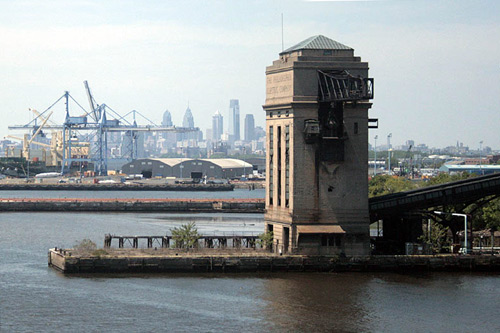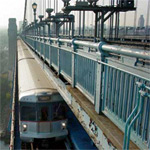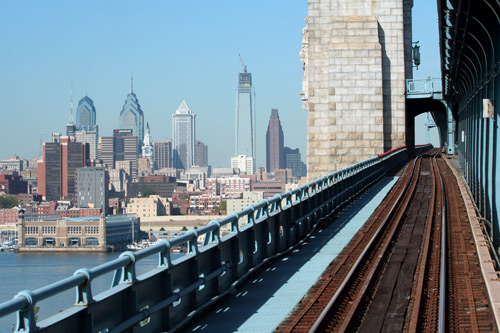|
|
|
24 September 08: Rivers and rails
Bridges of the Delaware commentary from Steve Ives

Long before the advent of the car, these were the primary means of travel for people and goods across long distances. The Pennsylvania Railroad, The B & O and the
Union Pacific became the great channels of commerce in this country and they mimicked, and sometimes followed, the routes of The Ohio, The Delaware or The Hudson
Rivers around which the first great cities grew and prospered. Many of the great American cities of yesteryear achieved their status through the conspicuous
exploitation of these original highways.
Today, while still relevant, these original conduits are looked back on almost as romantic relics. The great rivers are no longer lined with smoke belching
foundries and teeming with barges and our railroads are no longer the glamorous means of intercity travel, mingling the masses that board at quaint countryside
sheds and alight in marvelous structures once considered the front doors of great cities. They're a part of our lives as city dwellers because they've always been
there and as long as the city remains, so shall they. One of their great contributions now, as they in some ways have been relegated to the background of everyday
life, is their value in the abstract and something wondrous often seems to stir in the imagination at the place where the river meets the rails.
In the case of Philadelphia, there are several places where this occurs, sometimes beautifully and sometimes painfully not. At the two locations where it occurs
over the Delaware, Philadelphia's original front door, the experience of looking out over the water and the city as you vault over the river present two very
different experiences that are both genuinely Philadelphian.
Coming from the Delair Bridge, which carries freight and Atlantic City trains from New Jersey to the Northeast Corridor mainline, one leaves the green scenery and
the occasional car dealership of Burlington County behind to enter Philadelphia. The experience of riding across the bridge can be fun if one allows it to be. The
scenery reminds you of another era - steel trusses along the sides, city skyline off in the distance, ships downriver. Take the ride on a foggy night and the
experience can be Noir-ish. It isn't sleek, it doesn't feel terribly modern but it feels right for a place like Philadelphia -- and then you reach the bottom.
Seemingly eternal stretches of junk cars. A mothballed power plant. I-95. Undeveloped real estate. Past this buffer you can see and sense the city beyond. The
atmosphere changes from end to end but there is time enough to watch the city emerge from behind the remnants of industry. Seeing it all below on either side, one
would hardly know a river is nearby but once the bridge is reached, it makes a bit of sense.

It's the industrial side of the river's legacy. The ungainly cogs that make a region go. Nothing here is pretty (not even the bridge) but it's all necessary. It's
the working river. You've come in through the service entrance.
A bit downriver, though, the experience is quite different. One neither emerges from green fields nor enters brown ones. Where at the Delair Bridge, giving a sense
of amazement or arrival probably never entered the minds of its designers (and why would it?), at the Ben Franklin Bridge, it seems to have at least been
considered.
 Where you can take Boston's Red Line across the Longfellow Bridge, or the D train from DUMBO to Canal Street across the Manhattan Bridge, PATCO across the Ben
Franklin is how one takes a flying leap across the river into the center of Philadelphia. Though similar to the Delair in the sense that the view is not totally
unobstructed, it brings one into the city in a different air. The city isn't a just out of reach destination -- it's in your face there. Just feet to the left,
cars and buses whiz by. Down below, Delaware Avenue and I-95 and The El all intersect with you. One feels a part of the blood flow of the city, moving straight to
the heart. The active uses of the river are neither distant nor abstract. Homes beckon from just beyond the water line. Boats docked beneath the bridge. Everything
is up close. One gets that feeling of entering right at the front door. This is the living river.
Where you can take Boston's Red Line across the Longfellow Bridge, or the D train from DUMBO to Canal Street across the Manhattan Bridge, PATCO across the Ben
Franklin is how one takes a flying leap across the river into the center of Philadelphia. Though similar to the Delair in the sense that the view is not totally
unobstructed, it brings one into the city in a different air. The city isn't a just out of reach destination -- it's in your face there. Just feet to the left,
cars and buses whiz by. Down below, Delaware Avenue and I-95 and The El all intersect with you. One feels a part of the blood flow of the city, moving straight to
the heart. The active uses of the river are neither distant nor abstract. Homes beckon from just beyond the water line. Boats docked beneath the bridge. Everything
is up close. One gets that feeling of entering right at the front door. This is the living river.
So what is the common factor between both of these experiences? It's at the river where it is the most exhilarating. It's only at the river where people get the
urge to crane their necks and press noses to the glass. And what makes these experiences truly Philadelphian? They both present this city's exasperating dual
nature. The experience of entering the city at the front door, over the Ben Franklin, feels proper. It's the right way to come into a place like this. There's
energy around and everything feels large. The experience at the Delair gives you the nitty gritty side, the obligatory, sometimes hidden parts of the city, the
inelegant facilities that make the pretty face possible.
The two experiences give you the two faces of The Delaware and Philadelphia as a whole. While driving your car across one of the bridges you may not be able to
devote enough time to looking directly beneath you and seeing how the city unfolds from the river's edge to the streets. You've got toll plazas and traffic circles
to worry about. The ability to gaze out a window and wonder has always been one of the great aspects of riding trains and coming in through one of these two
gateways gives you an opportunity to think about how the city has grown around the river.
–Steve Ives
phillytrax@aol.com

STEVE IVES ARCHIVES:
|
|
|